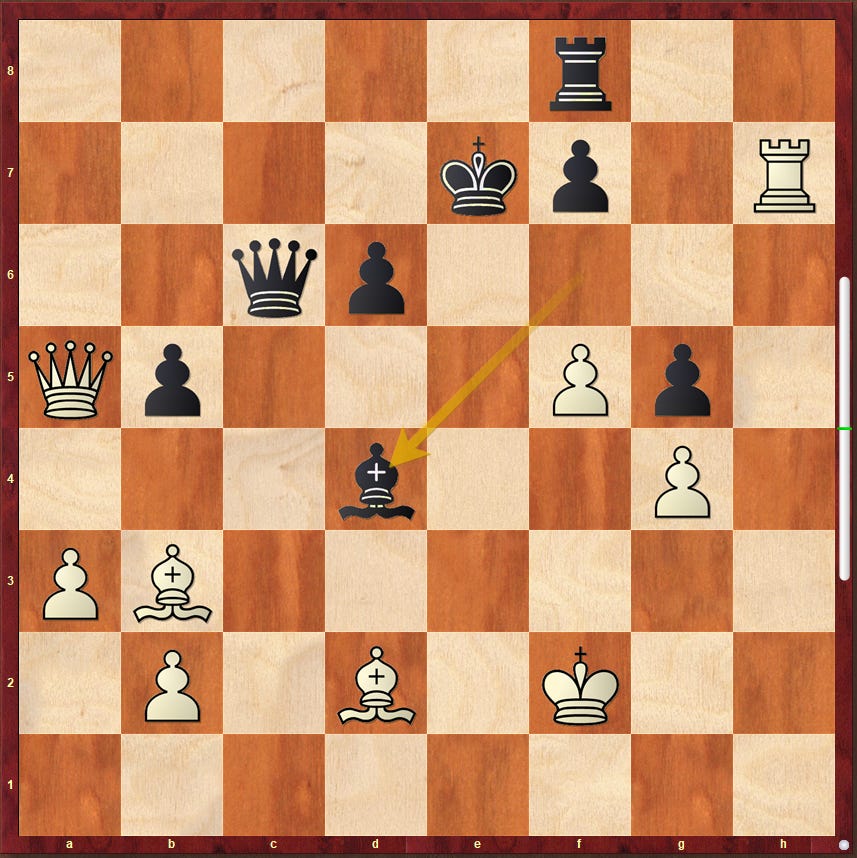It's been almost a year since I last wrote an article on my Substack. I hereby apologize to my subscribers and readers for such a long break. But if you thought I had stopped playing chess, I haven't :-) I still play chess, the last year even the most in the last 10 years. But because of that there has been less time to write.
I definitely want to keep publishing Queenspawn's substack, but not on a regular weekly rhythm. I hope you'll still be supportive though.
I'm currently playing a spring tournament using the 9-round Swiss system. We've played 5 rounds, my record is +2, =2, -1. Nothing excellent, but no flop either.
In the last round I played the following game. I had black pieces and I have to say I didn't feel comfortable in the position at all. I lacked any idea for an active counterplay (except for the knight moves). Fortunately, around move 30 the game opened up and even though I stood worse, my pieces at least got some play.
Even so, I didn't have good position for most of the game, and the game itself is full of various inaccuracies.
So why did I decide to share this game with you?
Because I think it is an example of how a chess player should not give up too soon. He should fight to the end. Because there's a well-known rule: "A game I give up or draw I can never win again."
White: Jiri Macoun (1725 FIDE ELO)
Black: me (1831 FIDE ELO)
Time Control: 90 minutes per 40 moves, then 30 minutes to the end (no increment)
1. e4 c5 2. Bc4 Here we go. I don't like this variation in Sicilian with the bishop on c4. I haven't yet figured out how to properly position the black position to have an active game. And this game didn't show me the way either.
2… d6 3. Nc3 Nf6 4. d3 Nc6 5. a3 g6 6. f4 e6 7. Ba2 Bg7 8. Bd2 O-O 9. Nf3
So... what now? A break in the center didn't seem like a good idea, so I opted for the standard take space on the queenside.
9…. a6 10. O-O b5 11. Qe2 Nd7
It was time for the knight moves. I just didn't see any other plan. At this point in the game I was extremely frustrated with my position. The funny thing is that Fritz sees this position as equal and unproblematic for Black.
12. Ng5 Nd4 13. Qd1 Nf6 14. Rb1 Qc7 15. Be3 Nc6 16. Ne2 Ng4 17. Bd2 Nd4 18. c3 Nxe2+ 19. Qxe2 Nf6 20. Rf2 Bd7 21. Rbf1 Qd8 22. h3
The breakthrough for White on e5 or f5 squares is in the air and now was probably the first moment it could have come (on e5 square ).
22…. h6= 23. Nf3 Bc6 24. g3 Nd7 25. Nh4 Qe7 26. Qd1 a5 27. f5
27… exf5
Fritz says that Black should stay calm and play 27…. Kh7=
28. exf5 g5
29. Ng6
It is an obvious move, but 29.f6 is even stronger because of 29…. Nxf6 30.Nf5
29…. Qf6 30. Nxf8 Rxf8 31. g4 Qe5
Hurray! Finally, I found a threat. And it's straight with checkmate. White has to surrender the material he's gained.
32. Rf3 Bxf3 33. Qxf3 Qe7 34. Re1 Ne5 35. Qe4 Qd7 36. Rf1 Bf6 37. Bd5 Re8 38. Re1 Rc8 39. Kg2 Kf8 40. h4 Nc6
41. hxg5 hxg5 42. Rh1 Re8 43. Qf3 Ne5 44. Qg3 Ke7 45. Rh7 Rf8 46. d4 cxd4 47. cxd4 Nc6 48. Qc3 Nxd4 49. Qxa5
Zugzwang is here. No matter what move I make, I either lose material or get checkmate. I could have given up, but I discovered that after 49.... Nb3 I "sacrificed" the knight for activity, and I thought that maybe in the following checks my opponent will lose and I'll be reduced to an perpetual check. Objectively, 49…. Nb3 is a mistake.
49…. Nb3? 50. Bxb3 Qc6+ 51. Kf2 Bd4+
52. Ke2?
And it is here! 53.Be3 solves everything
52…. Qe4+ 53. Kd1 Qb1+ 54. Bc1 Qd3+ 55. Qd2 Qxb3+ 56. Qc2 Qf3+ 57. Qe2+ Qxe2+ 58. Kxe2
And we have an equal position now. But since I had the last 3 minutes on the clock (no increment), the draw offer was not on the table. Now, however, I believed that I would get at least a draw on the board as well.
58….Bf6 59. b3 Rc8
60. Rh5?
Oops.
60…. Rxc1 61. Kd2 Ra1 62. Rh2?
Oops, he did it again.
62… Ra2+ 0-1
The main lessons learned from this game:
I need to work on how to build Black's position after 1.e4 c5 2.Bc4 to have a chance for an active counterplay.
During pawn breakthroughs, look more to see if there are other defensive moves available other than switching pawns (22…. Kh7).
Don't give up too early and try to play to the end (regardless of the clock). Even at this level, tactical mistakes still often decide games, and there's an opportunity for them at any time.
















OMG 😱 What a messy game! 😜 Thanks for sharing. 😀